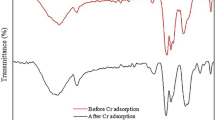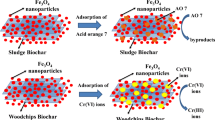Abstract
Reverse flotation technology is one of the most efficient ways to improve the quality and reduce impurity of iron concentrate. Mineral processors dealing with hematite face a challenge that the flotation results of reverse flotation of hematite are poor in presence of siderite using fatty acid as collector, starch as depressant of iron minerals and calcium ion as activator of quartz at strong alkaline pH. In this work, the effect of siderite on reverse anionic flotation of quartz from hematite was investigated. The effect mechanism of siderite on reverse flotation of hematite was studied by solution chemistry, ultraviolet spectrophotometry (UV) and Fourier transform infrared spectroscopy (FTIR). It was observed that siderite had strong depressive effect on quartz in flotation using sodium oleate as collector, corn starch as depressant of iron minerals and calcium chloride as activator of quartz at strong alkaline pH. The starch was adsorbed onto calcium carbonate by chemical reaction which was formed by CO3 2- from siderite dissolution and Ca2+ from calcium chloride as activator of quartz and precipitated on the surface of quartz, which resulted in improving the hydrophilic ability of quartz.
Similar content being viewed by others
References
SUN Bing-quan. Progress in china’s beneficiation technology for complex refractory iron ore [J]. Metal Mine, 2005, 8: 31–34. (in Chinese)
UWADIALE G G O O. Flotation of iron oxides and quartz [J]. A review. Mineral Processing and Extractive Metallurgy Review, 1992, 11(3): 129–161.
PAPINI R M, BRANDÃO P R G, PERES A E C. Cationic flotation of iron ores: amine characterization and performance [J]. Minerals and Metallurgical Processing, 2001, 18(1): 5–9.
ARAUJO A C, VIANA P R M, PERES A E C. Reagents in iron ores flotation [J]. Minerals Engineering, 2005, 18(2): 219–224.
MOWLA D, KARIMI G, OSTADNEZHAD K. Removal of hematite from silica sand ore by reverse flotation technique [J]. Separation and Purification Technology, 2008, 58(3): 419–423.
LIMA N P, VALADÃO G E S, PERES A E C. Effect of amine and starch dosage on the reverse cationic flotation of an iron ore [J]. Minerals Engineering, 2013, 45: 180–184.
FILIPPOV L O, SEVEROV V V, FILIPPOVA I V. An overview of the beneficiation of iron ores via reverse cationic flotation [J]. International Journal of Mineral Processing, 2014, 127: 62–69.
IWASAKI I. Iron ore flotation. theory and practice [J]. Minerals Engineering, 1983, 35(6):622–631.
MONTES-SOTOMAYOR S, HOUO TR, KONGOLO M. Flotation of silicate gangue iron ores: mechanism and effect of starch [J]. Minerals Engineering, 1998, 11(1): 71–76.
WANG Yu-hua, REN Jian-wei. The flotation of quartz from iron minerals with a combined quaternary ammonium salt [J]. International Journal of Mineral Processing, 2005, 77(2): 116–122.
BIRINCI M, MILLER J D, SARIKAYA M, WANG Xu-ming. The effect of an external magnetic field on cationic flotation of quartz from magnetite [J]. Minerals Engineering, 2010, 23(10): 813–818.
HUANG Zhi-qiang, ZHONG Hong, WANG Shuai, XIA Liu-yin, ZOU Wei-bo, LIU Guang-yi. Investigations on reverse cationic flotation of iron ore by using a Gemini surfactant: ethane-1,2-bis (dimethyl-dodecyl-ammonium bromide) [J]. Chemical Engineering Journal, 2014, 257: 218–228.
MA X, MARQUES M, GONTIJO C. Comparative studies of reverse cationic/anionic flotation of Vale iron ore [J]. International Journal of Mineral Processing, 2011, 100(3/4): 179–183.
TURRER H D G, PERES A E C. Investigation on alternative depressants for iron ore flotation [J]. Minerals Engineering, 2010, 23(11/12/13): 1066–1069.
LIU Ai-guo, WU Rong-chang, ESCHENAZI E, PAPADOPOULOS K. AFM onhumic acid adsorption on mica [J]. Colloids and Surfaces A: Physicochemical and Engineering Aspects, 2000, 174(1): 245–252.
MATTEDI V A, OLIVEIRA J F. Adsorption of starch onto apatite and magnetite and their selective flotation [J]. In: VI Southern Hemisphere Meeting on Mineral Technology, Rio de Janeiro, 2001, 1: 271–274.
PAVLOVIC S, BRANDÃO P R G. Adsorption of starch, amylose, amylopectin and glucose monomer and their effect on the flotation of hematite and quartz [J]. Minerals Engineering, 2003, 16(11): 1117–1122.
NANTHAKUMAR B, GRIMM D, PAWLIK M. Anionic flotation of high-iron phosphate ores—Control process water chemistry and depression of iron minerals by starch and guar gum [J]. International Journal of Mineral Processing, 2009, 92(1/2): 49–57
KAR B, SAHOO H, RATH S S, DAS B. Investigations on different starches as depressants for iron ore flotation [J]. Minerals Engineering, 2013, 49: 1–6.
LIMA R M F, BRANDÃO P R G, PERES A.E.C. The infrared spectra of amine collectors used in the flotation of iron ores [J]. Minerals Engineering, 2005, 18(2): 267–273.
CHEN Wen. Technological progress in processing low-grade fine-grained complicated refractory iron ores [J]. Metal mine, 2010, 5: 55–59, 80. (in Chinese)
LUO Xi-mei, YIN Wan-zhong, YAO Jin, SUN Chuan-yao, CAO Yang, MA Ying-qiang, HOU Ying. Flotation separation of magnetic separation concentrate of refractory hematite containing carbonate with enhanced dispersion [J]. The Chinese Journal of Nonferrous Metals, 2013, 23(1): 238–245. (in Chinese)
LIU Jie, ZHOU Ming-shun, ZHAI Li-wei, LIU Jiong-tian, CAO Yi-jun. Present status of china’s complex refractory iron ore study [J]. China mining magazine, 2011, 20(5): 63–66. (in Chinese)
ZHANG Ming, LV Zhen-fu, YIN Wan-zhong, HAN Yue-xin. Influence of the siderite in donganshan iron ore on reverse flotation [J]. Metal mine, 2007, 9: 62–64. (in Chinese)
YANG Bin. Study on separation technology and mechanism of siderite and hematite [D]. Changsha: Central South University, 2010. (in Chinese)
JIANG Hao, LIU Guo-rong, Hu Yue-hua, XU Long-hua, YU Wa-wen, XIE Zhen, CHEN Hao-chuan. Flotation and adsorption of quaternary ammonium salts collectors on kaolinite of different particle size [J]. International Journal of Mining Science and Technology, 2013, 23(2): 249–253.
MA Song-bo. Froth flotation of hematite with starch as depressant [D]. Shenyang: North East University, 2006. (in Chinese)
YE H, Matsuoka I. Reverse flotation of fine quartz from dickite with oleate [J]. International Journal of Mineral Processing, 1993, 40(1/2): 123–136.
BEÉNÉZETH P, DANDURAND J L, HARRICHOURY J C. Solubility product of siderite (FeCO3) as a function of temperature (25-250 °C) [J]. Chemical Geology, 2009, 265(1/2): 3–12.
MARTA M, HÉIÈNE B, GUILLAUME F, FRANCOIS G. In-situ monitoring of the formation of carbon compounds during the dissolution of iron (II) carbonate (siderite) [J]. Chemical Geology, 2011, 290(3/4): 145–155.
YANG Shao-yan. Study on Theory and process of flotation of calamine [D]. Changsha: Central South University, 2010. (in Chinese)
TANG Pei-hui. Selective Flotation between apatite and siliceous gangue [D]. Changsha: Central South University, 2011. (in Chinese)
LI Ye, SOMASUNDARAN P, PINTO C L L. Adsorption properties and interaction mechanism of starch-type polysaccharides onto fluorite and calcite [J]. Nonferrous Metals, 1996, 48(1): 26–30.
PINTO C L L, ARAUJO A C, PERES A E C. The effect of starch, amylose and amylopectin on the depression of oxi-minerals [J]. Minerals Engineering, 1992, 5(3): 469–478.
Author information
Authors and Affiliations
Corresponding author
Additional information
Foundation item: Project (51374079) supported by the National Natural Science Foundation of China
Rights and permissions
About this article
Cite this article
Luo, Xm., Yin, Wz., Wang, Yf. et al. Effect and mechanism of siderite on reverse anionic flotation of quartz from hematite. J. Cent. South Univ. 23, 52–58 (2016). https://doi.org/10.1007/s11771-016-3048-6
Received:
Accepted:
Published:
Issue Date:
DOI: https://doi.org/10.1007/s11771-016-3048-6




